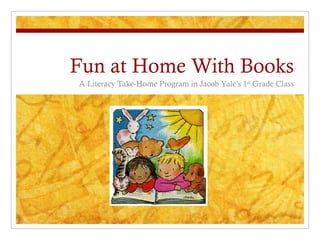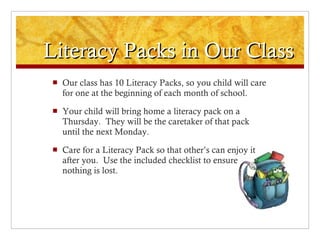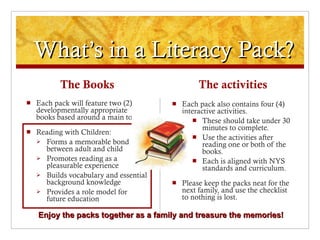Literacy Home Pack Family Presentation
- 1. Fun at Home With Books A Literacy Take-Home Program in Jacob Yale’s 1 st Grade Class
- 2. Why Read at Home? “ The single most important activity for building the knowledge required for eventual success…is reading aloud to children.” - Commission on Reading Report “ We…lose 78 percent of our potential lifetime readers by senior year (of high school).” YOU have the power to change this! “ The more you read, the more you know; and the more you know, the smarter you grow” The Read-Aloud Handbook by Jim Trelease is an excellent resource!
- 3. Literacy Packs in Our Class Our class has 10 Literacy Packs, so you child will care for one at the beginning of each month of school. Your child will bring home a literacy pack on a Thursday. They will be the caretaker of that pack until the next Monday. Care for a Literacy Pack so that other’s can enjoy it after you. Use the included checklist to ensure nothing is lost.
- 4. What’s in a Literacy Pack? The Books Each pack will feature two (2) developmentally appropriate books based around a main topic. Reading with Children: Forms a memorable bond between adult and child Promotes reading as a pleasurable experience Builds vocabulary and essential background knowledge Provides a role model for future education The activities Each pack also contains four (4) interactive activities. These should take under 30 minutes to complete. Use the activities after reading one or both of the books. Each is aligned with NYS standards and curriculum. Please keep the packs neat for the next family, and use the checklist to nothing is lost. Enjoy the packs together as a family and treasure the memories!
- 5. Literacy Pack Goals S upport reading strategies that will be used in your child’s education T each the values of subjects your children learn in school E ngage your children in specific curriculum areas and standards through interactive activities P romote a life-long love of learning and reading S trengthen the bond between you and your child Let your child take S.T.E.P.S. to success!
- 6. The Literacy Pack Guide Parent Letter Materials Checklist Quick Guide to Activities Helpful Reading Tips Possible Discussion Questions & How to Use Them Feedback Forms
- 7. “ Cloudy With a Chance of Meatballs” Written by Jodi Barrett, Illustrated by Ron Barrett Grandpa reveals a story about the sleepy town of Chewandswallow where “It rained things like soup and juice. It snowed mashed potatoes and green peas. And sometimes the wind blew in storms of hamburgers.”
- 8. “ Weather Words and What They Mean” Written and Illustrated by Gail Gibbons Uses simple language and bright, colorful pictures to teach children basic weather concepts and introduce them to the science of meteorology.
- 9. Helpful Reading Tips Get comfortable in a familiar spot with plenty of light. Do whatever you can to enjoy reading-aloud yourself. Try to use a calm, rhythmic voice, and don’t be afraid to SLOW DOWN. Make reading aloud an interactive activity by stopping and exploring the pictures together as you read. Ask questions about the story, words, and pictures before, during, and after reading. This increases comprehension.
- 10. Possible Discussion Questions Cloudy With a Chance of Meatballs Why aren’t there any food stores in Chewandswallow? What happens when the weather and food are bad? How does working together help the town? General Questions: “ Who are the author and illustrator?” “ What do they do?” “ What does the cover tell us about the story?” “ What do you already know about weather?” Look at the pictures with your child and ask what they notice. Weather Words and What They Mean What is weather made up of? Which weather words do you already know? What words do you want to know? Why is it important to know about the weather?
- 11. Connections to Curriculum Weather Literacy Pack That Wacky Wind ~SCIENCE~ Make a Weather Journal ~ELA~ Track the Changes ~MATH~ Paint a Cloud Portrait ~ART~
- 12. Activity 1: Make a Weather Journal! Objective: Students will demonstrate proficiency in writing by completing one or more of several writing activities. Option 1: Let your child make their own 4-page weather journal to use while you care for the pack Option 2: Your child can include their favorite type of weather on the last page of the journal. Option 3: Make weather fact cards with tour child they can share with their friends! Standard Met: ELA Standard 1 – Language for information and understanding
- 13. Activity 2: Paint a Cloud Portrait! Objective: Students will demonstrate their ability to work with a variety of mediums by creating one of several engaging projects. Option 1: Your child can create a picture of the sky they observe, using cotton balls to model the clouds. Option 2: Their picture can be expanded by including the environment beyond the sky, such as the city or park. Option 3: Clouds can be labeled with their scientific names, using a reference guide Standard Met: Arts Standard 1 – Creating, Performing, and Participating in the arts
- 14. Activity 3: That Wacky Wind! Objective: Students will demonstrate their understanding of weather concepts by creating and exploring tools and toys that show how the wind works. Option 1: Make a pinwheel with your child that really spins as they or the wind blow on it. Option 2: Let your son or daughter make and learn about windsocks that work the same as the real ones! Option 3: Go fly a kite as a family that your child made themselves! Standard Met: Science Standard 4 – Students will understand and apply scientific concepts, principles and theories
- 15. Activity 4: Track the Changes! Objective: Students will demonstrate their familiarity with math concepts by counting, graphing, and making sense of data. Option 1: Play a dice game with your child and let them keep a tally of the weather! Option 2: Turn the tally marks into a graph together and explore the new way of seeing the same information. Option 3: Answer some simple questions about the data to completely understand the information. Standard Met: Math Standards 3 and 4 – Students will understand math concepts and become mathematically confident with age appropriate material
- 16. References Barrett, J. (1978). Cloudy with a chance of meatballs. New York: Simon & Schuster. Gibbons, G. (1990). Weather words and what they mean . New York: Holiday House. Primary Classroom Resources. Display borders and trimmers . Retrieved from http://www.primaryclassroomresources.co.uk Queensland Government. (2000). Power for a sustainable future . Retrieved from http://www.sustainableenergy.eq.edu.au/ Trelease, J. (2006). The read-aloud handbook . New York: The Penguin Group.
- 17. Please Enjoy the Refreshments! Feel free to ask me any questions you still have!
















